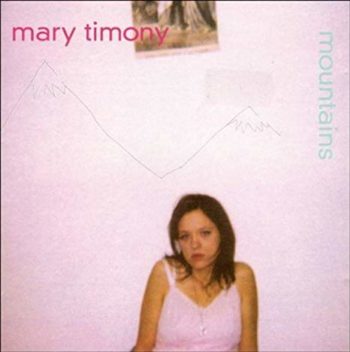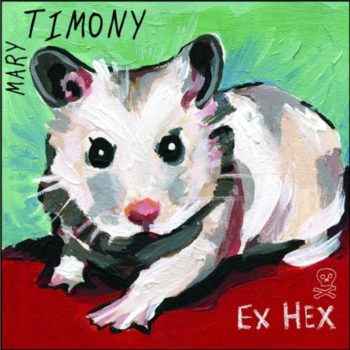Huh. Guess we’re in full Retrospecticus mode here. Here’s one that probably features way less things you’ve heard of…
There was something very satisfying about seeing the modest success of Ex Hex at the halfway point of this decade, seeing as it was a long time coming for the band’s frontwoman Mary Timony. Sure, she had some indie level success in the ‘90s with Helium, perhaps on about the same level as Ex Hex. But something about Rips just meant a little more, since in the wake of the ‘90s, she just kept toughing it out, making music in relative obscurity before finding a more simplified, anthemic formula to transmit her immense talent through.
As I said, it was a long time coming, and it’s pretty interesting to traverse the road that Timony took to finally get there. It’s not often you find an artist who first finds success sounding fairly unconventional, then becomes even more unconventional, and then eventually morphs into something resembling mainstream rock. Yet, that’s the path that Mary Timony forged, and without ever compromising her prowess as a guitarist and songwriter.
For this Retrospecticus, I’ll be looking at basically every album she was heavily involved with. Many of her bands released EPs, which I’m choosing to skip even if some of Timony’s projects only released EPs (like her first side project with Carrie Brownstein, The Spells), and therefore will not be featured. Also, that would’ve required more work, and I had enough on my hands, considering I’d only extensively listened to Timony’s 2010s albums prior to my research for this post. Oh, and if you hadn’t assumed already, Ex Hex has a new album coming out in a few hours… Let’s get started.

 Helium is the kind of band that both seems very emblematic of their time, but also were a bit too odd to become super successful during it. Yes there is the crunch and plunk of ‘90s indie rock coursing throughout The Dirt of Luck, and there are plenty of tasty melodies to sink your teeth into throughout. But the songs often go from happy and upbeat to dark and sinuous, often over the course of the same song.
Helium is the kind of band that both seems very emblematic of their time, but also were a bit too odd to become super successful during it. Yes there is the crunch and plunk of ‘90s indie rock coursing throughout The Dirt of Luck, and there are plenty of tasty melodies to sink your teeth into throughout. But the songs often go from happy and upbeat to dark and sinuous, often over the course of the same song.
I do have to wonder if the push and pull that’s often at the heart of this band has to do with Timony’s musical background. She went to an Arts high school as a teen, playing multiple instruments and being labeled a bit of a prodigy. That proficiency is clear in Timony’s guitar playing, but it also belies a kind of restlessness and will to pull apart every melody she concocts. It makes for what isn’t necessarily the most accessible example of ‘90s indie rock, but is certainly one of the most distinctive.

 Considering the period it was made in, The Magic City has kind of a familiar vibe to it. The ‘90s were a time where lots of bands made the leap from indie to major labels, and in the process, there was usually a noticeable change when bands made said leap. Sometimes this was for the best, and sometimes it wasn’t. But often the bands would do roughly the same thing as on their indie releases, but with more polished production, and with the conviction that there was more on the line now.
Considering the period it was made in, The Magic City has kind of a familiar vibe to it. The ‘90s were a time where lots of bands made the leap from indie to major labels, and in the process, there was usually a noticeable change when bands made said leap. Sometimes this was for the best, and sometimes it wasn’t. But often the bands would do roughly the same thing as on their indie releases, but with more polished production, and with the conviction that there was more on the line now.
Of course, Helium never made the leap from Matador to a major label, perhaps because they were a bit too late for the post-Nirvana alt-rock boom. But either way, this album has a lot of the same trademarks of Helium’s first album, but everything’s just a little more fully-realized. And therefore, in many ways feels like their big major label album.
On The Magic City, Mary Timony adds a noticeable amount of keyboards to complement her guitarwork, and yet the album always retains a kind of raggedness and peculiarity synonymous with their sound. The 8-minute “The Revolution of Hearts Pt I and II” also serves as evidence why Helium were never terribly easy to categorize, and also points toward the proggier elements of Timony’s solo career.

 I don’t have much way of finding this out, but I do have to wonder if Mary Timony was going through some sort of personal crisis before recording this album. One also has to wonder if the more fantasy-based lyrics of Mountains were a way for her escaping said crisis. You could also make the case that the somber, alienated sound of Mountains could have to do with the break-up of Helium, but considering Helium drummer Ashe Bowie is credited on the album, I can’t assume it was a terribly painful break-up. Perhaps Timony was just interested in expressing the more baroque sounds featured on this album, and couldn’t do that in the more rock-oriented confines of Helium.
I don’t have much way of finding this out, but I do have to wonder if Mary Timony was going through some sort of personal crisis before recording this album. One also has to wonder if the more fantasy-based lyrics of Mountains were a way for her escaping said crisis. You could also make the case that the somber, alienated sound of Mountains could have to do with the break-up of Helium, but considering Helium drummer Ashe Bowie is credited on the album, I can’t assume it was a terribly painful break-up. Perhaps Timony was just interested in expressing the more baroque sounds featured on this album, and couldn’t do that in the more rock-oriented confines of Helium.
And by “baroque”, I mean that in a fairly discordant way. There’s lots of piano and some violins on Mountains, but it’s often used in combination with dissonant percussion and stringy acoustic guitar. None of these are things that would’ve felt out of place on a Helium record, but the songs are just a lot more dour than on Timony’s former band’s recordings. Often times misery can translate to something kind of mesmerizing, but on Mountains, the dourness tends to make the album more of a slog than something worth pouring over.

 After making an album as inscrutable as Mountains, Mary inched a little closer towards something resembling conventional singer/songwriter rock on The Golden Dove. Still, there are plenty of weird string arrangements and somber piano motifs throughout the album, so it’s still a bit in that same mopey vein. And even the more rock-oriented numbers like “Blood Tree” have a kind of angular, moody disposition. The album has a tendency to make you work for the catchier moments, though it’s debatable if those moments are worth it or not.
After making an album as inscrutable as Mountains, Mary inched a little closer towards something resembling conventional singer/songwriter rock on The Golden Dove. Still, there are plenty of weird string arrangements and somber piano motifs throughout the album, so it’s still a bit in that same mopey vein. And even the more rock-oriented numbers like “Blood Tree” have a kind of angular, moody disposition. The album has a tendency to make you work for the catchier moments, though it’s debatable if those moments are worth it or not.
It’s also debatable whether I’m being too hard on the wallowing nature of these first two solo albums from Mary Timony. Maybe because the version of her I know best is in Wild Flag and Ex Hex, and so I’ve become more accustomed to the “fun” version of her music. But there is a nice push and pull in the Helium stuff between more introspective experimenting and the hardened exterior of traditional guitar music. But on these solo albums, I don’t know man. They come off as the definitions of solo albums that were made for the sake of trying new things regardless of whether they were intended for human consumption. Which, for a musician as idiosyncratic and flat-out talented as Timony, is somewhat intriguing but never anything more than that.

 Considering this album shares the same name as Timony’s future band, you may wonder… does it feature the same rock and roll kickass-ery of Ex Hex (the band)? Well, sort of. Album opener “On the Floor” certainly points the way for a much more straightforward rock sound that Timony can pull off quite easily. This is furthered by veteran indie rocker Devin Ocampo, lending a newfound amount of stomp behind the drumkit. This nicely complements Mary’s guitar-playing, which takes center stage much more prominently than on her previous two keyboard-centric albums.
Considering this album shares the same name as Timony’s future band, you may wonder… does it feature the same rock and roll kickass-ery of Ex Hex (the band)? Well, sort of. Album opener “On the Floor” certainly points the way for a much more straightforward rock sound that Timony can pull off quite easily. This is furthered by veteran indie rocker Devin Ocampo, lending a newfound amount of stomp behind the drumkit. This nicely complements Mary’s guitar-playing, which takes center stage much more prominently than on her previous two keyboard-centric albums.
You could say that this is the album where Timony starts to veer into more classic rock territory, with some of the songs featuring guitar interludes that really sprawl out. Still, the discordant nature of her previous solo albums is there a bit, as is the whimsical nature of the lyrics. Like on say, “Return To Pirates”, where Timony pines to hang out with little white doves. But more than anything, Ex Hex sounds like an artist getting a second wind of ferocity at a time in her career when perhaps it would’ve been easy to succumb to the realities of alt-rock’s unfulfilled “dream of the ‘90s”.

 In many ways a precursor to the rockin’ sounds of Timony’s work in Wild Flag and Ex Hex, though it has a bit of a proggy/jammy feel that Ex Hex traded in for catchy conciseness. Once again, Devin Ocampo is behind the drums and gives Timony’s guitar work an extra bit of punch. Overall, there’s a bit of a psychedelic garage rock vibe to the album, though the more I write about Mary Timony’s music, the more I find it’s a little hard to define because she seems to incorporate so many different rock subgenres. So it makes it almost harder to think of types of rock music she hasn’t incorporated into her sound.
In many ways a precursor to the rockin’ sounds of Timony’s work in Wild Flag and Ex Hex, though it has a bit of a proggy/jammy feel that Ex Hex traded in for catchy conciseness. Once again, Devin Ocampo is behind the drums and gives Timony’s guitar work an extra bit of punch. Overall, there’s a bit of a psychedelic garage rock vibe to the album, though the more I write about Mary Timony’s music, the more I find it’s a little hard to define because she seems to incorporate so many different rock subgenres. So it makes it almost harder to think of types of rock music she hasn’t incorporated into her sound.
I do have to wonder if Mary decided to record this album under the “Mary Timony Band” moniker because it was written and recorded with more of a band dynamic. It certainly has that feel to it, like it was borne more out of jamming than Timony writing some songs and then adding different overdubs on top of it. Some of that works well in the jammier songs, but the album works best when it just goes for a full-throttle sound. Take for instance album opener “Sharpshooter”, or “Curious Minds”, which has a kind of energy that could only come from three people jamming with each other in the same room.

 When Wild Flag’s lone album came out in 2011, I knew it was the work of a supergroup, though I barely had any context for why Wild Flag was a supergroup. I knew a little of Sleater-Kinney at the time, and really had no prior knowledge of Mary Timony, though I knew instantly that her witchy vocals had a certain allure to them. Regardless, I was a fan after this album, while I also felt obligated to check out more Sleater-Kinney (which I thankfully did).
When Wild Flag’s lone album came out in 2011, I knew it was the work of a supergroup, though I barely had any context for why Wild Flag was a supergroup. I knew a little of Sleater-Kinney at the time, and really had no prior knowledge of Mary Timony, though I knew instantly that her witchy vocals had a certain allure to them. Regardless, I was a fan after this album, while I also felt obligated to check out more Sleater-Kinney (which I thankfully did).
Maybe it’s a little weird to include this in the grand scheme of Mary Timony’s work, considering this album features Carrie Brownstein singing lead on a lot of songs. But as I said, it was where I first became aware of Mary Timony. Also, I have to wonder if playing Wild Flag pushed her in the direction of Ex Hex, once the geographically disparate members of Wild Flag called it quits.
There’s a conciseness and a punchiness to this album that you saw glimpses of in Mary Timony’s previous two solo albums, but was always a little too bogged down in unusual guitar solos and spacey keyboards to ever be something you wanted to pump your fist to. But maybe that should be attributed to the girls from Sleater-Kinney. I mentioned the fact that Timony has a way of combining all sorts of different rock subgenres, though curiously punk had been missing from her milieu, despite spending her formidable years in Washington D.C. at the height of hardcore. But here she gets a little taste of riot grrrl by swapping bars with some of the titans of the genre, and in the process rocking about as hard as she ever had.

 I more or less stand by how I felt about this album when it was released in 2014. This is just a wonderfully rockin’ album, and one that has a formula that is by no means unique, but the execution is just so damn good. I suppose I now have the first-hand knowledge that this came from years of experience writing songs on the part of Miss Timony, who really always had an indelible ear for melody. She just had a tendency to hide these melodies in less conventional instrumentation than your typical guitar-bass-drum combo.
I more or less stand by how I felt about this album when it was released in 2014. This is just a wonderfully rockin’ album, and one that has a formula that is by no means unique, but the execution is just so damn good. I suppose I now have the first-hand knowledge that this came from years of experience writing songs on the part of Miss Timony, who really always had an indelible ear for melody. She just had a tendency to hide these melodies in less conventional instrumentation than your typical guitar-bass-drum combo.
I remember during some interviews surrounding this first Ex Hex album, Mary Timony talked a bit about how she got to a point in her life where just wanted to make music that was fun. I know for a lot of artists, this would translate to “I just wanna make money”. But that doesn’t ever feel like the case here. Timony and her bandmates are creating very catchy music, but it’s also indebted to a vintage mixture of glam, punk, and garage rock that feels very outside of anything resembling contemporary pop music. And in the process it feels like the most instantly pleasurable album of Timony’s career, and yet feels just as singular as anything she’s ever done.
